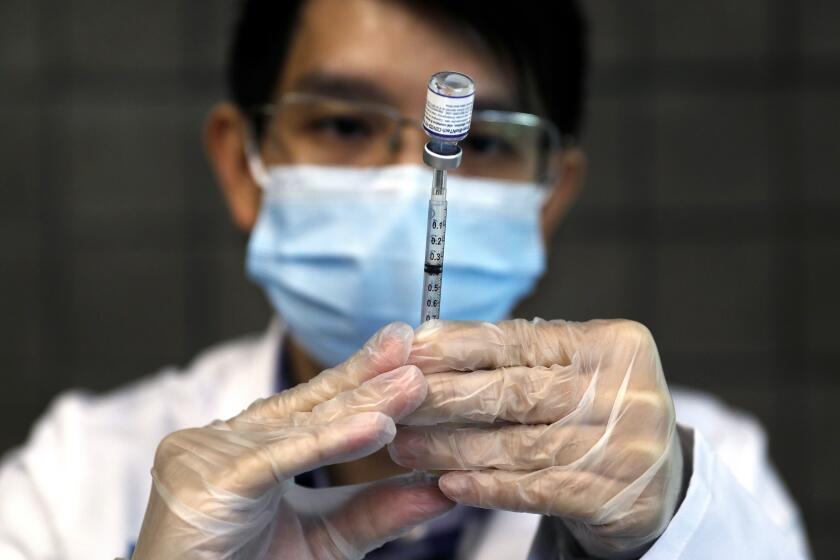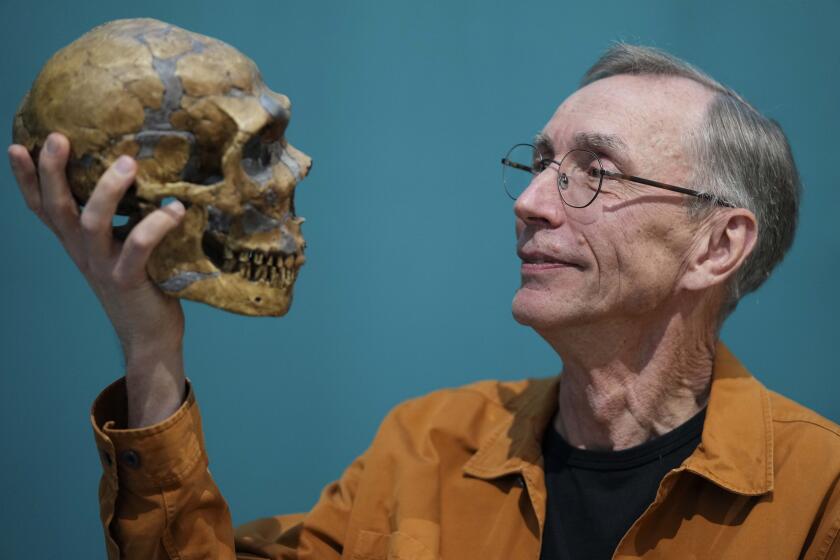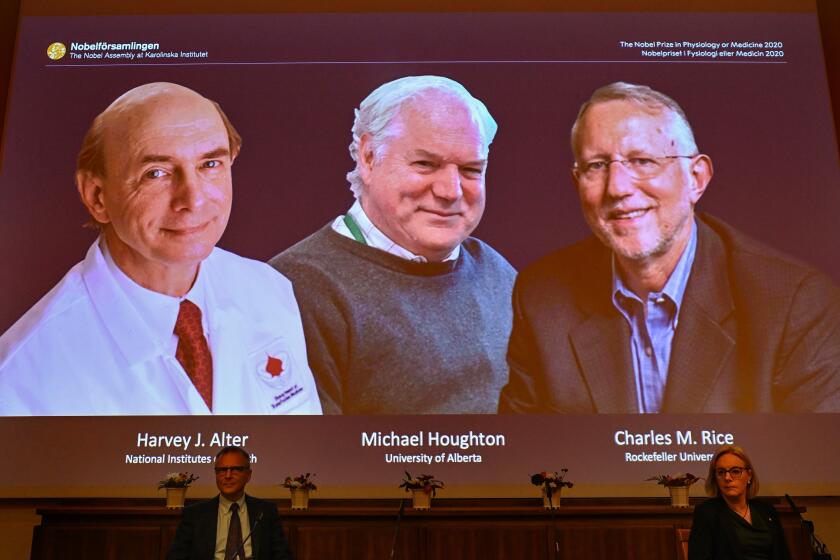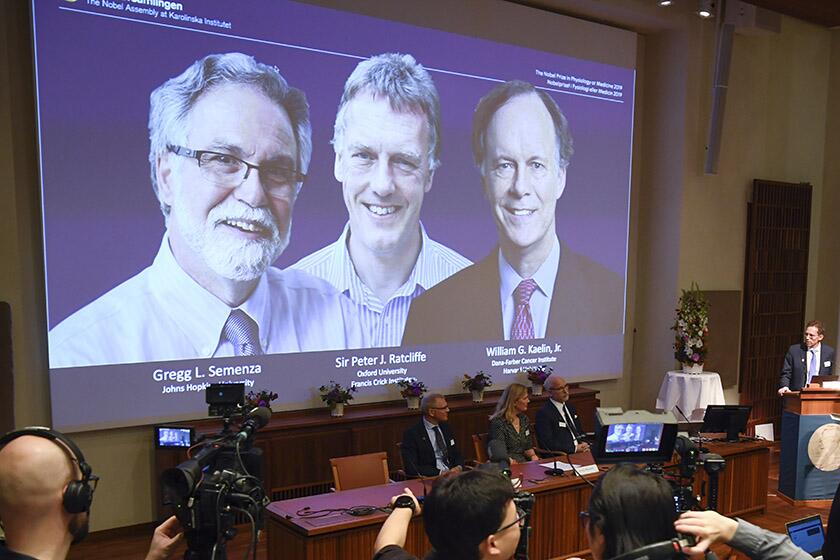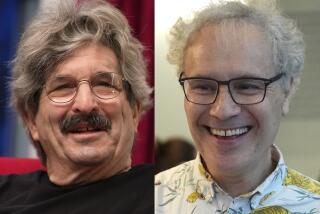Scientists whose work on mRNA paved the way for first COVID-19 vaccines win Nobel Prize
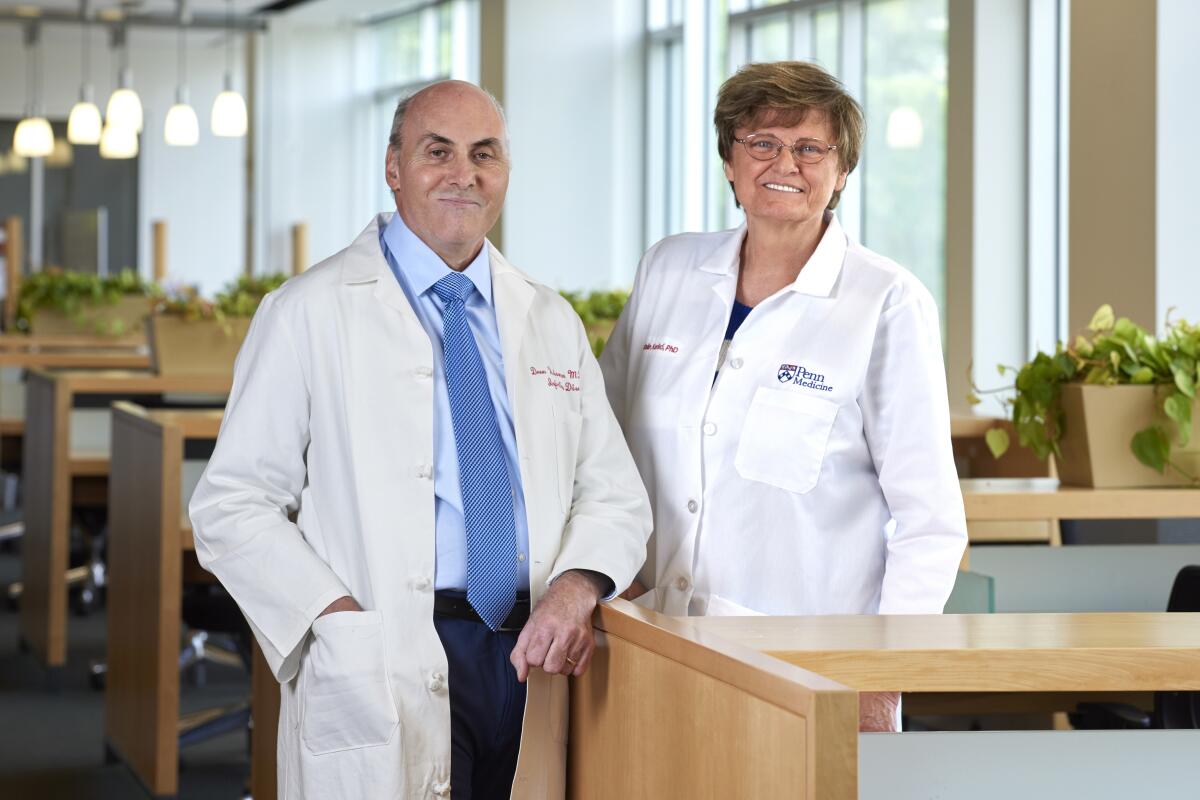
Katalin Karikó and Dr. Drew Weissman, American scientists whose long collaboration has revolutionized the making of vaccines and raised the prospect of new treatments for a range of afflictions, were awarded the Nobel Prize in physiology or medicine Monday for their work on messenger RNA.
Hungarian-born biochemist Karikó, 68, spent nearly a decade at BioNTech, the German pharmaceutical firm that collaborated with drug giant Pfizer to produce the COVID-19 pandemic’s first vaccine against the virus that causes COVID-19. Physician-scientist Weissman, 64, is a professor of vaccine research at the University of Pennsylvania’s Perelman School of Medicine.
Their work has armed scientists and drug companies with the means to turn the body’s cells into manufacturers of its own medicine.
“This year’s Nobel Prize recognizes their basic science discovery that fundamentally changed our understanding of how mRNA interacts with the immune system and had a major impact on society during the recent pandemic,” said Rickard Sandberg, a member of the Nobel Assembly, noting that mRNA vaccines, together with other COVID-19 shots, “have been administered over 13 billion times.”
Thomas Perlmann, the secretary-general of the Nobel Assembly, said both Karikó and Weissman were “overwhelmed” when he notified them of the award, especially Karikó, given her tumultuous professional history.
“Ten years ago, she told me that she was terminated from her current position and had to move to Germany for another position without her family and so forth,” Perlmann said. “So it’s been a dramatic change in her circumstances.”
Although mRNA rose to public prominence for its use in COVID-19 vaccines, the technology is expected to become a major basis for flu vaccines, enabling shorter lead times and more accurate matching between circulating influenza strains and yearly shots.
Beyond that, it could play a key role in treating sickle-cell disease and shows promise for the autoimmune disorder multiple sclerosis. Its potential use in treating cancers is also opening new avenues for arming the immune system against malignancy.
A new COVID-19 vaccine is coming, and health officials are recommending most everyone get it. But how many people are willing to roll up their sleeves again?
HIV could be the next target. Three new experimental vaccines to protect against HIV infection, all based on an mRNA design similar to that used in the COVID-19 jab, are now undergoing early human clinical trials.
The techniques pioneered by Karikó and Weissman have enabled scientists to nimbly customize the proteins targeted by vaccines, a key for thwarting shape-shifting viruses such as the coronavirus and HIV.
Such capabilities more than proved their worth during the pandemic. The mRNA vaccines made by Pfizer-BioNTech and Moderna were both designed within weeks of the release of the SARS-CoV-2 coronavirus genome, and were the first to come off manufacturing lines for worldwide use. Today, the two COVID-19 vaccines are in use in at least 164 countries, and roughly 270 million Americans have received at least one dose.
That “impressive success story” alone would make recognition of Karikó and Weissman by the Nobel Committee “proper and appropriate,” said Dr. Anthony Fauci, former director of the National Institute of Allergy and Infectious Diseases and chief medical advisor to President Biden. But advances the pair made in the use of mRNA have only begun to be felt in medicine, he added.
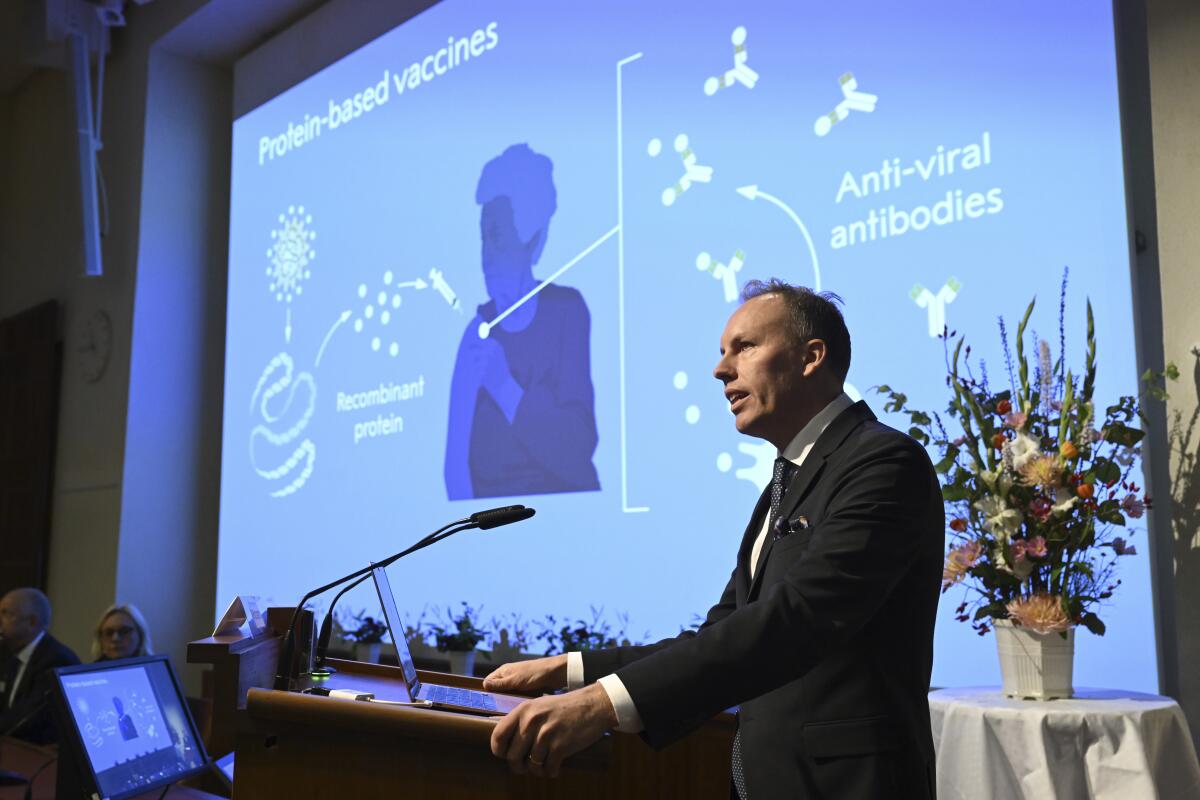
Karikó was first introduced to ribonucleic acid, or RNA, in 1978 and said she’s been “passionate about this fragile molecule ever since.” She was exploring DNA’s use of messenger RNA to deliver specific work orders to cells when she met Weissman over a photocopy machine at the University of Pennsylvania in 1997.
Antiretroviral medications were just entering wide use against HIV/AIDS at the time, and Weissman was trying to design a vaccine against a disease that was killing hundreds of thousands of Americans each year. He had been intrigued by the possibility that mRNA could induce cells to produce proteins that the body was missing or that it needed to heal itself. But he knew that efforts to repurpose this delicate nucleic acid for medical purposes had hit a host of stumbling blocks.
Svante Paabo’s discoveries on human evolution provided key insights into our immune system and what makes us unique compared with our extinct cousins.
Karikó was intimately familiar with the obstacles to mRNA’s use. And she was well aware of the skepticism directed its way by the scientific community. After earning a doctorate in biochemistry at Hungary’s University of Szeged and immigrating to the United States in 1985, she had been determined to find ways to harness mRNA for treatments.
By the time she met Weissman, Karikó had been an itinerant postdoctoral researcher for more than a decade. At Temple University in Philadelphia, the Uniformed Services University of the Health Sciences in Bethesda, Md., and the University of Pennsylvania, she had tried to drum up support for work on mRNA’s biomedical uses. She had a drawer full of rejected grant proposals to show for it.
Weissman’s research pedigree was more promising. A biochemistry major at Brandeis University, Weissman earned his medical degree and a doctorate at Boston University and was awarded a postdoctoral fellowship in Fauci’s lab at the National Institutes of Health. While there, he studied a key node of the mammalian immune system — dendritic cells — and their perturbation in HIV/AIDS.
Weissman knew that messenger RNA had an incidental effect on dendritic cells: Their interaction touched off an immune response that ignited dangerous inflammation across the body.
Weissman and Karikó both realized that until that problem could be fixed, mRNA would be of limited biomedical use, and no use at all in making vaccines. There was also the problem of mRNA’s fragility outside of cells: Unpackaged, it was easily chewed up by enzymes, and getting it through cells’ outer walls was no picnic either.
The two scientists formed a partnership of grit and grace. Over more than two decades, Karikó’s and Weissman’s experiments shed more light on how mRNA could be repurposed to enter cells and safely order up the production of certain proteins. They watched how other nucleic acids snuck past the immune system unnoticed and devised a fix that enabled mRNA to ferry new work orders into cells without causing flares of inflammation.
Two Americans and one Briton share the Nobel Prize in medicine for their discovery of the hepatitis C virus.
“Each spark of something interesting, whether a finding we expected — or even more exciting, the ones we didn’t — motivated us to continue,” Weissman said in a speech accepting the 2021 Lasker Award, one of several prestigious scientific honors the pair have won in recent years.
“Together we designed and conducted experiments, often trading emails into the early hours — unable to wait until the next day to share particular findings or ideas,” Weissman said. “We just kept at it.”
By 2004, the two had produced a paper that detailed their success at reengineering mRNA for use in mammals. In an interview with the journal Cell, the two recalled that their first paper together was rejected by the three premier science journals — Cell, Science and Nature. One reviewer dismissed the work as a mere “incremental improvement” over existing research in the area.
Karikó said she had to look up “incremental” in the dictionary. Undeterred, the pair got their paper published in a specialty journal, Immunity, in 2005. Then they waited for the conference invitations to pour in.
“We sat and stared at the phone, and nothing happened,” Weissman said. After presenting the paper at one conference, Karikó said a fellow scientist came up and asked who had supervised her work — the kind of question no one would ask a man of her age.
Not until 2010, after the pair published findings that further improved the prospects for mRNA’s use, did the medical establishment start to take notice. By 2012, Weismann and Karikó led a team that showed that mRNA, introduced into mice, could prompt the temporary production of red blood cells.
Start your day right
Sign up for Essential California for the L.A. Times biggest news, features and recommendations in your inbox six days a week.
You may occasionally receive promotional content from the Los Angeles Times.
“They had to do some really fancy manipulation to allow it to persist long enough” inside the body to ferry genetic instructions into cells, Fauci said. “They were persistent, resilient, and they stuck to it,” he added. “It’s a great example of the scientific process.”
In 2013, Karikó left the University of Pennsylvania to join BioNTech, reasoning that pharmaceutical companies would eclipse universities in devising treatments using mRNA technology.
When the SARS-CoV-2 virus emerged in China in 2019, BioNTech had already used mRNA technology to design a vaccine against the Zika virus, which had infected hundreds of thousands of pregnant women and caused grievous birth defects across the world. Moderna, too, had been working on a Zika vaccine, as well as vaccines against cytomegalovirus infection and cancers.
Within two weeks of the publication of the SARS-CoV-2 virus’ genetic sequence, both companies had what they needed to build a vaccine. They used different formulations for the delivery of mRNA, but once inside a human cell, the vaccines provided the genetic specifications for producing harmless replicas of the coronavirus’ spike proteins. The human immune system would take it from there.
When health officials in the U.S. and United Kingdom ordered up a new crop of COVID-19 booster shots that targeted the Omicron variant, all Pfizer-BioNTech and Moderna had to do was insert a key piece of genetic code that matched the desired strains. The updated shots were ready in mere months.
Weissman has established laboratories in Thailand, South Africa and other low- and middle-income countries to devise COVID-19 vaccines that can be produced locally. His research continues to explore ways for mRNA vaccines to provide more enduring protection against COVID-19 by training the immune system to recognize pieces of the virus that are much less prone to mutation.
In addition, Weissman has joined with other scientists to counter the misinformation and disinformation about COVID-19 shots that has made many people unwilling to roll up their sleeves.
“As important as the vaccine is, if you don’t take it, it doesn’t work,” he said in an interview Monday with nobelprize.org, adding that the endorsement from the Nobel committee might help sway some of those who have been hesitant.
The 2019 Nobel Prize in physiology or medicine was awarded to William Kaelin Jr., Peter Ratcliffe and Gregg Semenza for work on how cells use oxygen.
He remains at the University of Pennsylvania, and is married to Mary Ellen Weissman. They have two daughters, Rachel and Allison.
Karikó left BioNTech in 2022 but is still a consultant for the company. She is now a research professor at the University of Szeged and an adjunct professor at the University of Pennsylvania.
Karikó is married to Béla Francia, who she said encouraged her decision to commute to BioNTech in Germany when she lost her position at Penn. The couple and their daughter, Zsuzsanna “Susan” Francia, arrived in the United States in 1985 with their life savings — about $1,000 — sewn into the stuffing of a teddy bear. (Susan Francia grew up to become a decorated rower, winning two Olympic gold medals for the United States.)
“I try to tell fellow female scientists that you don’t have to choose between having a family, you can have it,” she told nobelprize.org on Monday. “Your child will watch you and they will do, because that’s what counts, the example that you present.”
Through it all, Karikó has said she was not deterred by her lack of funding, the lack of interest from the medical establishment or the slow pace at which she and Weissman uncovered mRNA’s secrets.
“I am so glad it helped humanity,” Karikó told a University of Pennsylvania interviewer. But for decades, the process of scientific discovery was its own reward, she added.
“So many enigmatic things about RNA I find very, very exciting,” Karikó said. She and Weissman would ask questions and then design experiments to answer them.
“And of course, instead of the answer, we got 100 more questions,” she added. “It was very enjoyable. I would like to emphasize that to be a scientist is a joy.”
